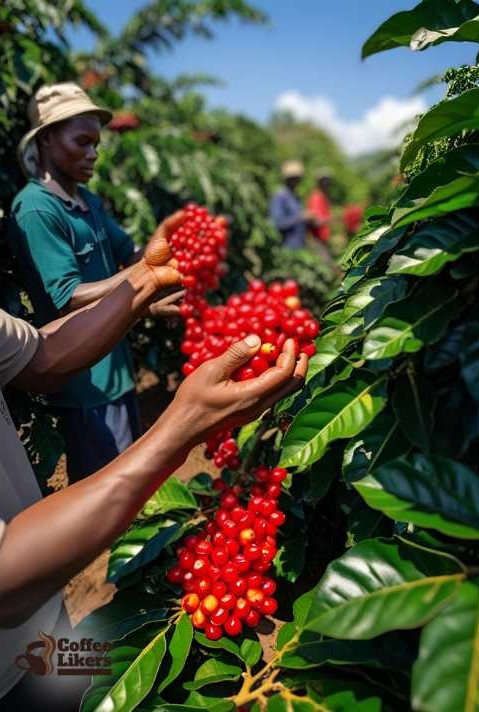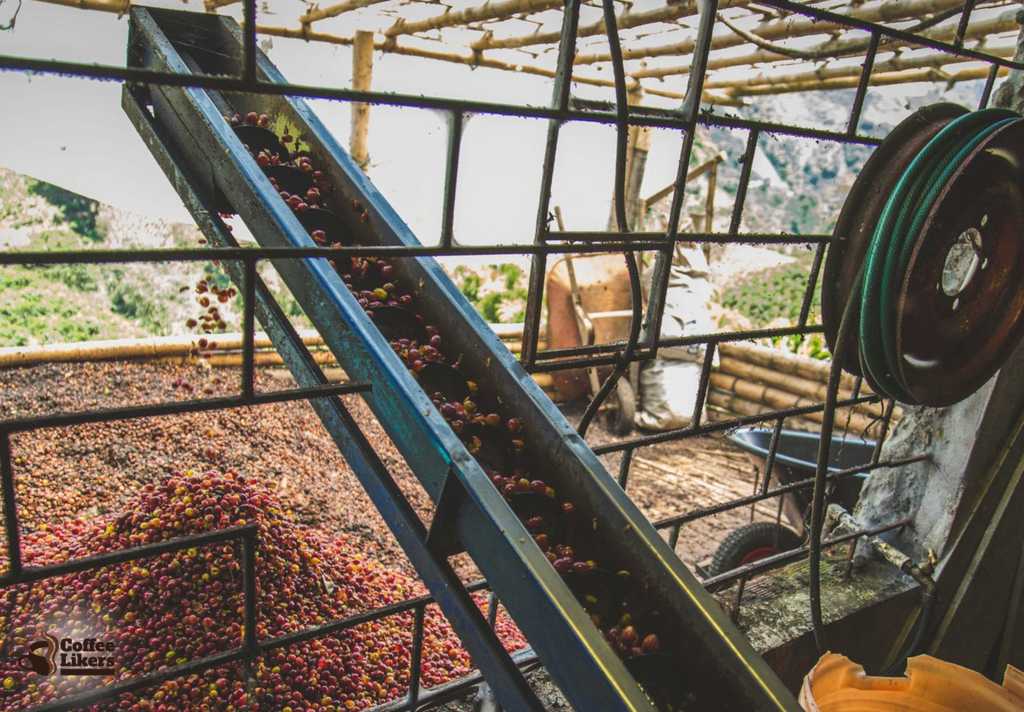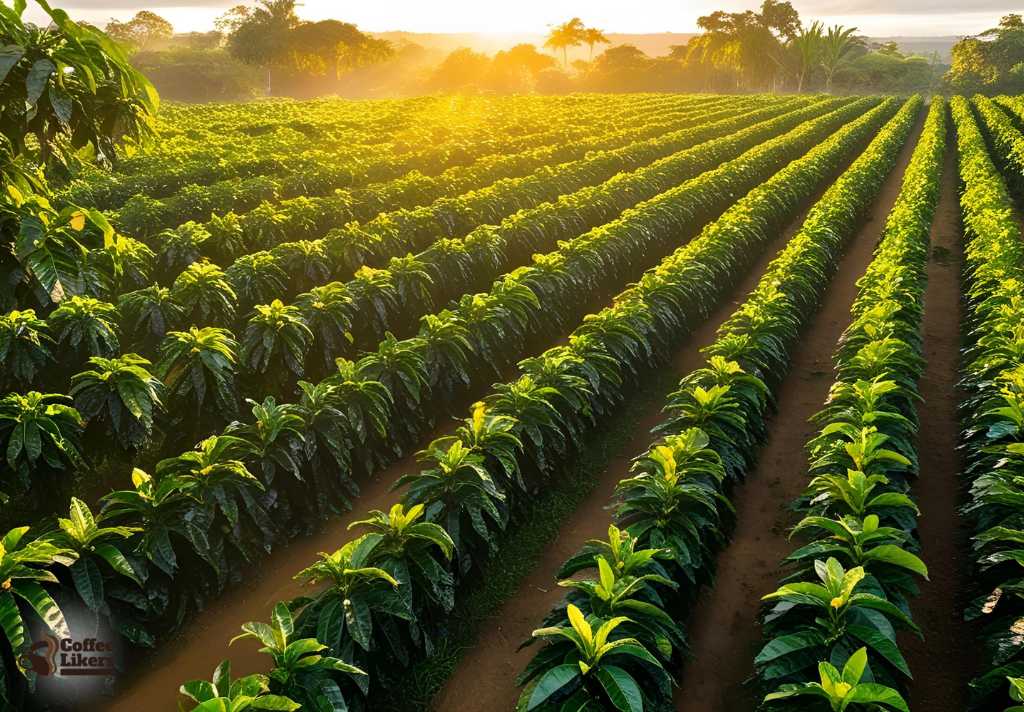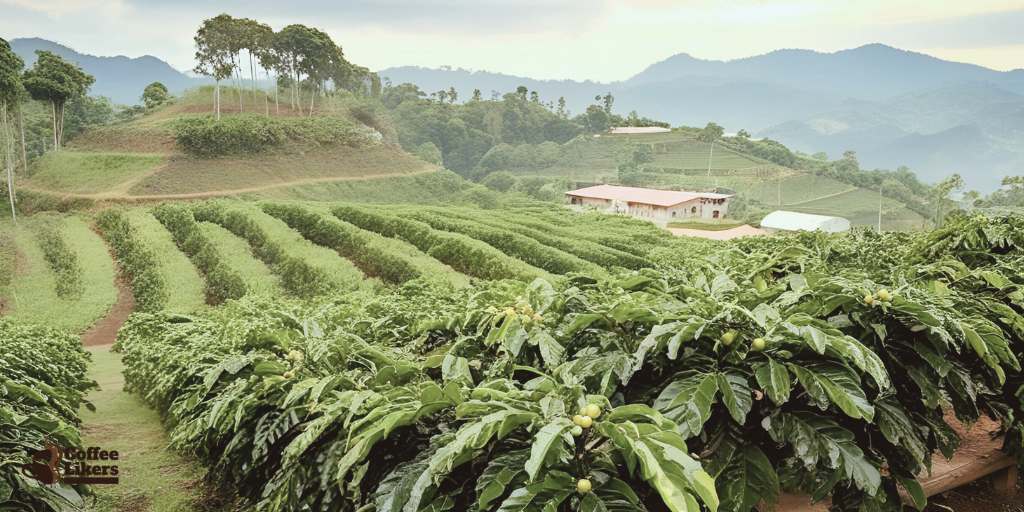This article will discuss the Robusta coffee plantation, which is important in today’s coffee industry. They have a strong flavor and more caffeine. Some people used to think Arabica beans were better.
But now, more people are realizing the special qualities of Robusta. It can also handle climate change well, making Robusta beans more popular in the world of coffee production.
Robusta coffee farms have been getting more attention in recent years because they can handle environmental changes. Climate change is a big problem for coffee, but Robusta beans are tough.
People like the higher caffeine in Robusta beans because it gives a stronger flavor. Robusta coffee’s place in the coffee market is expanding as more consumers discover its unique flavor. The future looks bright for Robusta Farms.
The demand for Robusta coffee is going up because it’s used in espresso blends, instant coffee, and special drinks. Its bold taste and affordability appeal to many.
Robusta coffee is becoming popular with coffee lovers and baristas. With its flexibility and ability to adapt, Robusta Coffee is set to become a big player in the coffee industry in the future.
What are the ideal growing conditions for Robusta coffee plants? Robusta coffee plants like warm weather. They prefer temperatures between 24-30°C (75-86°F), lots of rain, and can handle tough weather conditions. This makes them perfect for lower areas where Arabica plants might not do well. Also, Robusta plants need soil that drains well and prefer some shade to shield them from strong sunlight.
Robusta Coffee Plantation: Brief Description
Robusta coffee comes from the Coffea canephora plant. Its strong nature and improved farming methods are evident. Although this coffee originated in Africa, it is now grown in many places around the world.
Robusta beans grow well in hot weather and low-lying areas. They have become an important part of the coffee market. They can resist pests and diseases and produce more beans, making them appealing to farmers who face the challenges of our changing environment.
Robusta Coffee Farming
Imagine walking through big green fields. The air is full of the sweet smell of coffee flowers. This is what Robusta coffee farming is all about.
It is a practice that people have gotten better at over many years. Robusta plantations are often full of life. Their branches are heavy with the promise of high crop yields.
Robusta plants can grow well in warm and humid weather, unlike Arabica plants. This strength allows them to do well in areas with lower heights. This means coffee farming can happen in more places.
Robusta’s ability to change and its natural resistance to bugs have helped it become popular. This is especially true in areas where it is hard to keep the right conditions for Arabica.
Robusta Coffee Production
Robusta coffee is a big part of the global coffee industry. It makes up a large share of the coffee consumed all over the world. Every year, we measure its production in millions of kg bags. This shows how much people want and need it as coffee becomes more popular.
Vietnam is the top producer of Robusta coffee. Other countries in Southeast Asia and South America also produce it. The beans are usually picked between July and September, which is a busy time for coffee growers.
Robusta beans have a careful journey from the farms to the processing plants. They change from bright red cherries into the delicious brown beans that help many people start their day.
Best Climate For Robusta Coffee
As the weather changes, it’s getting harder for coffee farmers. Coffee needs the right amount of heat and rain to grow well. But the weather is becoming less easy to predict.
Robusta coffee can handle higher temperatures better than Arabica coffee. Even though climate change affects it too, Robusta gives hope to farmers dealing with unpredictable weather.
This kind of coffee can survive in warmer temperatures and changing rain patterns. It shows how flexible plants can be in a world with lots of environmental changes.
Robusta Coffee Growing Regions
Robusta coffee has spread all around the world. It first started in the green lands of West Africa and now grows in busy farms in Southeast Asia. This type of coffee can grow in places that people didn’t think were good for coffee.
The Ivory Coast shows how tough Robusta can be. In the wet areas of West Africa, Robusta coffee does well. Here are some important places where it grows:
Southeast Asia: Vietnam, Indonesia
Africa: Ivory Coast, Uganda
South America: Brazil
These areas, with their special weather and soil, are very important for the Robusta coffee market.

Characteristics Of Robusta Coffee Plants
Robusta coffee plants come from the Coffea canephora species.
These plants have two sets of chromosomes, which helps them be strong and adapt to different environments better than Arabica coffee plants.
Robusta varieties grow well and look bushier than Arabica. Their leaves are bigger and rounder, with wavy edges.
The beans are smaller and rounder than Arabica beans, and they have a unique crease on their surface.
Ideal Growing Conditions For Robusta Coffee Plantations
To make Robusta coffee plants grow well, it’s important to know where they naturally thrive and try to recreate that environment. Robusta plants are tough and can do well in places where Arabica plants struggle.
The best spots for growing Robusta are lower areas, typically below 600 meters above sea level. They do best in warm weather, between 24°C to 30°C (75°F to 86°F). Adequate rainfall, soil that drains well, and some shade also help them flourish.
Harvesting And Processing Methods For Robusta Coffee Beans
Harvesting Robusta coffee beans is a lot of work because it involves carefully picking ripe cherries, usually from July to September. These cherries are then processed using different methods, each affecting the taste of the final product.
The two most common ways to process Robusta coffee beans are:
Dry Processing: Cherries are dried whole, keeping the natural sugars of the fruit and creating a heavier body and earthy flavors.
Wet Processing: Cherries are pulped to remove the outer layers, then fermented and dried. This method produces a cleaner, brighter cup with higher acidity.
After processing, the beans are hulled, polished, and graded, ready to be turned from green coffee into the fragrant drink enjoyed worldwide.
Flavor Profile And Caffeine Content Of Robusta Coffee
Robusta coffee has a special taste. Its flavor is described as earthy and robust. It has more caffeine than Arabica coffee, which makes it taste more bitter and intense.
You can often taste hints of chocolate, nuts, and spices in a cup of Robusta coffee. Because of this, people who enjoy strong, rich coffee love it.
The higher caffeine also helps to energize, which is why many people choose it when they need a boost.

Popular Blends And Uses Of Robusta Coffee Beans In The Industry
The versatility of Robusta coffee beans goes beyond just making a regular cup of coffee. These beans have a unique taste and high caffeine levels, making them a popular choice in the coffee industry.
For instance, espresso blends often include Robusta beans. They help create the crema, that rich and creamy layer on top of a well-made shot.
Additionally, instant coffee frequently uses Robusta beans because they are less expensive and provide a strong caffeine kick.
From coffee shops that serve specialty coffee to grocery store shelves, Robusta beans have carved out a steady place in the vast world of coffee.

Sustainability Practices In Robusta Coffee Cultivation
The coffee industry is facing problems because of climate change and changes in the market. Because of this, there is a greater focus on using methods that are good for the environment and society throughout the supply chain to ensure the future of coffee, especially specialty coffee.
For Robusta coffee growing, this means using ways to save water, reduce pesticide use, and make sure working conditions are fair. By focusing on these important practices, the industry can move towards a future where delicious and ethically sourced coffee is available for many years.
Challenges Faced By Robusta Coffee Farmers
Robusta coffee plants are usually tougher than Arabica ones. However, farmers have their own problems. Market prices can change, and labor costs can go up, which can make it hard for them to make money.
Climate change makes things even more complicated. Unpredictable weather can lower crop yields and increase major pests and diseases. To deal with these new problems, farmers need to be creative, work together, and use sustainable farming practices.
Comparison Between Robusta And Arabica Coffee Varieties
Robusta beans and Arabica coffee are two distinct varieties of coffee. They each have their own special traits that affect their taste, how they are grown, and how much they cost.
Arabica coffee tastes smooth and sweet. It grows better in high places and cooler weather. However, Robusta beans are higher in caffeine and have a stronger, bitter flavor. Both types are important in the world of coffee.

Health Benefits Associated With Consuming Robusta Coffee
Robusta coffee is not just tasty and aromatic, but it also has many health benefits. It’s not simply for waking you up in the morning. This coffee has a lot of antioxidants, particularly chlorogenic acid.
These antioxidants may help improve brain function, lower the risk of chronic diseases, and enhance athletic performance.
Specialty Robusta is all about quality and unique flavors. Enjoying a cup of Specialty Robusta can give coffee enthusiasts a delicious and potentially healthy beverage.
The Economic Significance Of Robusta Coffee And It’s Plantations
Robust coffee farms are very important for the world’s economy. They help many farmers keep their jobs and play a big role in the coffee trade. As more people want coffee, we see how valuable Robusta farms are.
Today, the world doesn’t have enough coffee, and the market keeps changing. Robusta coffee is strong and gives more coffee, which is important for meeting coffee needs. Every year, millions of bags of coffee are traded, showing how crucial the Robusta coffee industry is for the economy.
Global Market Trends And Demand For Robusta Coffee Beans
Global market trends show that more and more people want Robusta coffee beans. The demand is going up because many people enjoy espresso drinks and want affordable coffee options. As a result, demand has increased.
Last year, the price of Robusta coffee beans went up a lot. This happened because of issues in getting the beans and because more people wanted them.
As the coffee industry changes, Robusta’s ability to adjust and lower its prices is important in meeting the world’s coffee needs.
FAQ About Robusta Coffee Plantation
Where Is The Robusta Coffee Plant Grown?
Robusta coffee comes from West Africa. Now, it grows in many parts of the world. This includes Southeast Asia, South America, and other places in Africa.
Is Robusta Difficult To Grow?
Robusta coffee plants are usually easier to grow than Arabica. They are resilient and have good environmental adaptation. They also produce high crop yields, which is why many farmers prefer them.
What Is The Difference Between Robusta And Arabica Plantations?
The main difference is how they are grown. Arabica production usually grows best in higher elevations and cooler temperatures. On the other hand, Robusta production can handle warmer weather and lower altitudes.
Who Is The Largest Producer Of Robusta Coffee?
Vietnam is the largest producer of Robusta coffee. It makes up a big share of the world’s total production.
Final Thought
As the coffee business changes, Robusta coffee is becoming more important. Organizations like World Coffee Research are working hard to unlock their genetic potential.
They are creating new types that can fight off diseases and thrive in different climates. This research and innovation will help Robusta coffee become more popular in the coffee industry. In this blog post, we have discussed the Robusta coffee plantation.
It will also help make sure there is always tasty and sustainable coffee available. With more people wanting special coffee and caring about the environment, Robusta coffee farms have a chance to do well and make a big impact on the coffee world.





Leave a Reply